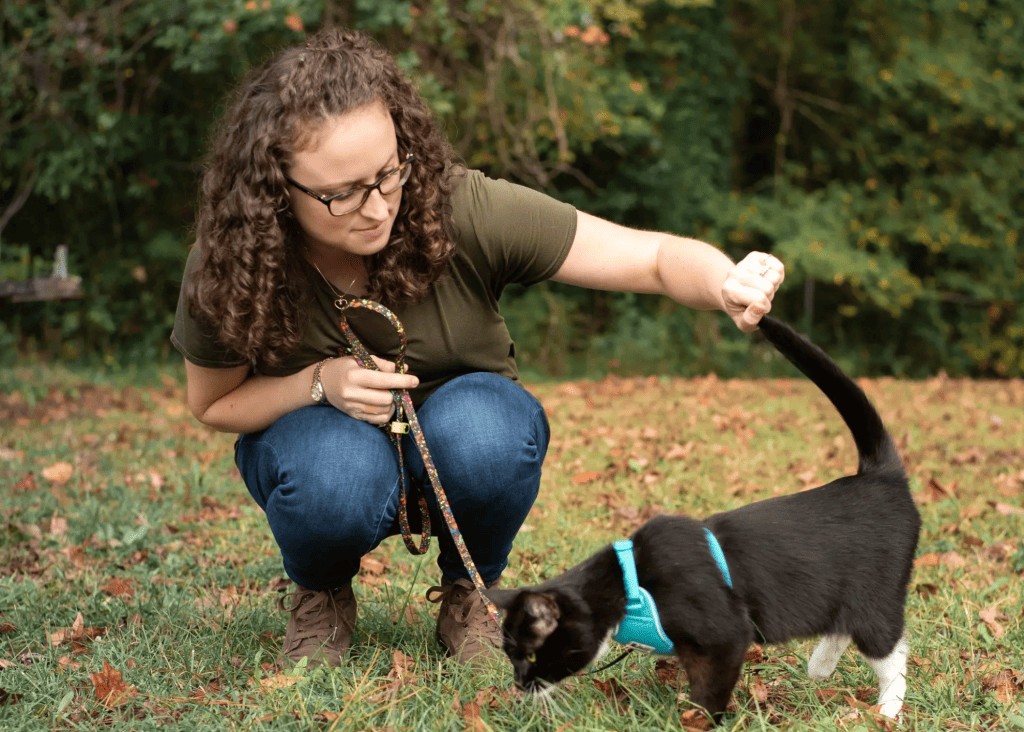Traveling with cats in a car might seem daunting, but it can be a rewarding experience with the right preparation. TRAVELS.EDU.VN is here to guide you through every step of the journey, ensuring a safe and enjoyable road trip for both you and your feline companion. Forget the hassle of pet sitters and embrace the adventure of traveling together. We offer expert advice and resources to make your cat’s car travel smooth, including choosing the right carrier and preparing for unexpected situations. Learn valuable tips and tricks for successful car trips with your cat by TRAVELS.EDU.VN.
1. Pre-Trip Planning: Setting the Stage for a Successful Journey
Before embarking on your adventure, meticulous planning is essential for a smooth and stress-free journey for both you and your feline friend. Consider these crucial aspects:
1.1. Choosing the Right Cat Carrier
The cat carrier serves as your cat’s safe haven during the journey. Select a carrier that is sturdy, well-ventilated, and appropriately sized for your cat to stand, turn around, and lie down comfortably.
- Hard-Sided Carriers: Offer superior protection and stability.
- Soft-Sided Carriers: Lighter and easier to carry, but may not offer the same level of protection.
- Crash-Tested Carriers: Provide the highest level of safety in case of an accident. The Sleepypod Mobile Pet Bed is a great option, doubling as a cat bed and a carrier. Its crash-tested design ensures your cat’s safety, providing peace of mind during travel.
 Sleepypod carrier for cat road trips
Sleepypod carrier for cat road trips
For longer trips, consider a more spacious carrier like the Pet Fit for Life carrier, which provides ample room for your cat to stretch and even includes a portable litter box.
1.2. Acclimatizing Your Cat to the Carrier
Introduce the carrier to your cat well in advance of the trip. Make it a comfortable and inviting space by placing familiar blankets, toys, and treats inside. Encourage your cat to enter the carrier voluntarily and spend time inside.
- Positive Reinforcement: Reward your cat with treats and praise when they enter the carrier.
- Gradual Introduction: Start with short periods inside the carrier, gradually increasing the duration.
- Familiar Scents: Spray the carrier with a cat-friendly pheromone spray like Feliway to reduce anxiety.
1.3. Practice Car Rides: Building Confidence
Start with short car rides around the block, gradually increasing the distance and duration. This will help your cat become accustomed to the motion of the car and the sounds of the road.
- Positive Associations: Offer treats and praise during and after each car ride.
- Calming Environment: Play calming music or use a pheromone diffuser in the car.
- Safe and Secure: Ensure the carrier is securely fastened in the car to prevent it from sliding around.
1.4. Cat-Friendly Accommodations: Planning Your Stays
Finding cat-friendly accommodations requires advance planning. Not all “pet-friendly” hotels welcome cats. Contact hotels directly to confirm their cat policies and any associated fees. Confirm cat-friendly policies and any extra fees to avoid surprises upon arrival. Websites like BringFido and PetsWelcome can help you find suitable lodging. TRAVELS.EDU.VN can assist you in finding and booking cat-friendly hotels, ensuring a comfortable stay for you and your feline companion.
1.5. Updating Identification: Ensuring a Safe Return
Ensure your cat’s ID tags are up-to-date with your current contact information. Microchipping provides an extra layer of security in case your cat gets lost.
- Visible ID Tags: Include your name, phone number, and address on the ID tag.
- Microchip Registration: Verify that your microchip registration is current and accurate.
- Temporary Tag: Consider adding a temporary tag with the address and phone number of your destination.
1.6. Packing Essentials: Creating a Cat Travel Kit
Prepare a dedicated travel kit for your cat, including:
| Item | Description |
|---|---|
| Food and Water Bowls | Lightweight and collapsible for easy packing and use on the go. |
| Cat Food | Pack enough for the entire trip, plus extra in case of delays. |
| Water | Bottled water to avoid any digestive upset from unfamiliar tap water. |
| Litter Box and Litter | A small, disposable litter box or a portable litter box that can be easily set up in the car or hotel room. |
| Litter Scoop and Bags | For easy and sanitary disposal of waste. |
| Pet Wipes | To clean up any messes or accidents. |
| First-Aid Kit | Including antiseptic wipes, gauze, bandages, and any medications your cat may need. |
| Medications | If your cat requires medication, ensure you have an adequate supply for the entire trip. |
| Calming Aids | Pheromone sprays or calming treats to help reduce anxiety during travel. |
| Toys and Comfort Items | Familiar toys and blankets to provide comfort and reduce stress. |
| Harness and Leash | If your cat is leash-trained, a harness and leash can be useful for walks during pit stops. |
| Pet Carrier | A safe and comfortable carrier for your cat to travel in. |
| Cleaning Supplies | Paper towels, odor neutralizer, and disinfectant spray to clean up accidents. |
2. Road Trip Day: Setting the Stage for Success
On the day of your trip, implement these strategies to minimize stress and ensure a smooth start:
2.1. Meal Timing: Avoiding Car Sickness
Avoid feeding your cat for several hours before the trip to reduce the risk of car sickness. Offer a light meal once you reach your destination.
- Empty Stomach: An empty stomach can help prevent nausea and vomiting.
- Hydration: Provide fresh water throughout the trip.
- Ginger: A small amount of ginger can help settle your cat’s stomach.
2.2. Veterinarian Consultation: Addressing Anxiety and Motion Sickness
Consult your veterinarian about potential medications or calming aids to alleviate anxiety or motion sickness.
- Prescription Medications: Your veterinarian may prescribe anti-anxiety medications or anti-emetics.
- Over-the-Counter Options: Pheromone sprays, calming treats, or herbal remedies may help reduce stress.
- Dosage and Timing: Follow your veterinarian’s instructions carefully regarding dosage and timing.
2.3. Pre-Trip Exercise: Reducing Energy and Stress
Engage your cat in a play session before the trip to expend energy and reduce anxiety.
- Interactive Play: Use toys like laser pointers, feather wands, or puzzle feeders.
- Mental Stimulation: Provide opportunities for your cat to explore and investigate.
- Physical Exertion: Encourage your cat to run, jump, and climb.
2.4. Encouraging Litter Box Use: Minimizing Accidents
Encourage your cat to use the litter box before the trip to minimize the need for bathroom breaks during the journey.
- Familiar Litter Box: Use your cat’s regular litter box and litter.
- Privacy: Provide a quiet and private space for your cat to eliminate.
- Positive Reinforcement: Reward your cat with treats and praise after using the litter box.
3. On the Road: Ensuring Comfort and Safety
Once you’re on the road, keep these considerations in mind to keep your cat comfortable and safe:
3.1. Essential Items: Keeping Necessities Within Reach
Keep a bag with essential items readily accessible, including water, treats, medications, and cleaning supplies.
3.2. Pit Stops: Providing Breaks and Relief
Plan regular pit stops every few hours to allow your cat to stretch their legs, drink water, and use the litter box. If your cat is harness-trained, take them for a short walk on a leash.
| Duration of Trip | Recommended Frequency of Pit Stops | Activities During Pit Stops |
|---|---|---|
| 2-4 Hours | Every 2 Hours | Offer water, allow stretching inside the carrier, provide a favorite toy. |
| 4-6 Hours | Every 2-3 Hours | Offer water, litter box access, gentle petting/reassurance, and a short walk on a leash if the cat is comfortable. |
| 6-8+ Hours | Every 2-3 Hours | Offer water, litter box access, gentle petting/reassurance, a short walk on a leash if the cat is comfortable, and a small meal or treat. |
| Overnight Trips | Every 2-3 Hours + Overnight Stay | Offer water, litter box access, gentle petting/reassurance, a short walk on a leash if the cat is comfortable, and a full meal. Ensure a comfortable overnight stay in a pet-friendly hotel. |
3.3. Never Leave Your Cat Unattended: Prioritizing Safety
Never leave your cat unattended in the car, especially during extreme weather conditions. If you need to leave the car, ensure the air conditioning or heat is running and the doors are locked. If traveling alone, consider using two sets of keys or asking someone to watch your cat while you are away.
3.4. Temperature Regulation: Maintaining a Comfortable Environment
Maintain a comfortable temperature in the car to prevent overheating or hypothermia.
- Air Conditioning: Use air conditioning to keep the car cool during hot weather.
- Heating: Use heating to keep the car warm during cold weather.
- Sun Protection: Use window shades to block direct sunlight.
- Ventilation: Ensure adequate ventilation to prevent stuffiness.
3.5. Recognizing Signs of Stress
Be attentive to your cat’s behavior and recognize signs of stress, such as:
- Excessive Vocalization: Constant meowing or crying.
- Panting: Rapid and shallow breathing.
- Restlessness: Inability to settle down.
- Hiding: Retreating to the back of the carrier.
- Aggression: Hissing, growling, or scratching.
If your cat exhibits signs of stress, take steps to calm them down, such as:
- Speak Softly: Reassure your cat with a calm and gentle voice.
- Offer Treats: Provide a favorite treat to distract them.
- Spray Pheromones: Use a pheromone spray to create a calming environment.
- Provide Comfort: Offer a familiar toy or blanket.
- Take Breaks: Stop the car and allow your cat to stretch their legs and use the litter box.
4. Advanced Tips and Considerations for Traveling With Cats
For cat owners seeking further expertise, here are some advanced tips to enhance the car travel experience.
4.1. Desensitization Techniques
- Sound Desensitization: Expose your cat to recordings of car sounds at low volumes, gradually increasing the volume over time.
- Motion Desensitization: Gently rock the carrier back and forth to simulate the motion of a car.
- Visual Desensitization: Show your cat pictures and videos of cars and roads.
4.2. Clicker Training
- Positive Reinforcement: Use a clicker to mark desired behaviors, such as entering the carrier or remaining calm during car rides.
- Gradual Shaping: Gradually shape the desired behavior by rewarding successive approximations.
- Consistency: Be consistent with your training and use the clicker only for desired behaviors.
4.3. Herbal Remedies
Explore the use of herbal remedies to reduce anxiety and promote relaxation.
- Chamomile: Known for its calming properties.
- Valerian Root: Can help reduce anxiety and promote sleep.
- Catnip: Can have a calming effect on some cats.
4.4. Acupressure Techniques
Learn acupressure techniques to relieve stress and promote relaxation.
- GV20: Located on the top of the head, can help calm the mind.
- Yintang: Located between the eyebrows, can help relieve anxiety.
- HT7: Located on the wrist, can help calm the heart.
4.5. Emergency Preparedness
Prepare for unexpected situations by packing an emergency kit.
- Extra Food and Water: In case of delays or unexpected events.
- First-Aid Supplies: For treating minor injuries.
- Copies of Medical Records: In case your cat needs veterinary care.
- Emergency Contact Information: For your veterinarian and local animal hospitals.
- Flashlight: For nighttime emergencies.
- Blanket: For warmth and comfort.
- Litter Box: For emergency bathroom breaks.
By implementing these advanced tips and considerations, you can further enhance the car travel experience for your cat and ensure a safe and enjoyable journey.
 woman holding cat outside and looking at camera
woman holding cat outside and looking at camera
5. Success Stories and Testimonials
“I was so nervous about taking Mittens on a road trip, but TRAVELS.EDU.VN’s guide made it so much easier. She actually seemed to enjoy the ride ” – Sarah J.
“Thanks to the tips on choosing the right carrier, our cat Whiskers was comfortable and relaxed the entire trip. We couldn’t have done it without TRAVELS.EDU.VN ” – Mark L.
6. Common FAQs about How to Travel With Cats in a Car
- Is it safe to let my cat roam freely in the car? No, it’s not safe. A carrier protects your cat in case of sudden stops or accidents.
- How often should I stop for breaks? Every 2-3 hours is recommended for water, bathroom breaks, and stretching.
- What if my cat gets car sick? Consult your vet for medication options and avoid feeding before the trip.
- How can I keep my cat calm during the drive? Use pheromone sprays, calming treats, and familiar toys.
- Can I leave my cat alone in the car for a few minutes? Never leave your cat unattended, especially in extreme weather.
- What documents do I need for my cat when traveling? Vaccination records and health certificates may be required, especially when crossing state lines.
- How do I handle litter box needs during the trip? Use a disposable litter box or pee pads in the carrier, and offer regular bathroom breaks.
- What if my cat escapes during a pit stop? Ensure your cat is microchipped and wearing identification tags. Keep a secure hold on the leash and harness.
- How can I make the carrier more comfortable? Place a familiar blanket or bed inside and spray with a calming pheromone.
- What are the best ways to prepare my cat for a long car ride? Gradual acclimatization to the carrier and short practice drives are essential.
7. Travel to Napa Valley With Your Cat Stress-Free Thanks To TRAVELS.EDU.VN
Imagine exploring the rolling vineyards of Napa Valley with your feline friend by your side. With TRAVELS.EDU.VN, this dream can become a reality. We take the stress out of planning, ensuring a seamless and enjoyable experience for both you and your cat.
Why Choose TRAVELS.EDU.VN?
- Expert Cat Travel Planning: We understand the unique needs of cats and tailor our services to ensure their comfort and safety.
- Cat-Friendly Accommodation: We partner with hotels and rentals that welcome cats, providing a stress-free stay for you and your pet.
- Customized Itineraries: We create personalized itineraries that include cat-friendly activities and attractions, allowing you to explore Napa Valley together.
- 24/7 Support: Our dedicated support team is available around the clock to assist you with any questions or concerns.
Experience the Best of Napa Valley with Your Cat
Napa Valley offers a variety of cat-friendly activities, including:
- Vineyard Strolls: Enjoy leisurely walks through picturesque vineyards (on a leash, of course!).
- Outdoor Dining: Many restaurants with patios welcome well-behaved cats.
- Scenic Drives: Explore the stunning landscapes of Napa Valley from the comfort of your car.
 woman with cat outside on a harness and leash
woman with cat outside on a harness and leash
Let TRAVELS.EDU.VN Handle the Details
Don’t let the challenges of planning a cat-friendly trip hold you back. TRAVELS.EDU.VN can handle all the details, including:
- Transportation: Arranging cat-friendly transportation to and from Napa Valley.
- Accommodation: Booking cat-friendly hotels and rentals.
- Activities: Planning cat-friendly activities and attractions.
- Support: Providing 24/7 support throughout your trip.
8. Ready to Embark on Your Napa Valley Adventure? Contact TRAVELS.EDU.VN Today
Don’t let the challenges of planning a cat-friendly trip hold you back. Contact TRAVELS.EDU.VN today to start planning your unforgettable Napa Valley adventure with your feline companion. Our team of experts is ready to assist you with every step of the process.
Contact us:
- Address: 123 Main St, Napa, CA 94559, United States
- WhatsApp: +1 (707) 257-5400
- Website: TRAVELS.EDU.VN
Let travels.edu.vn make your Napa Valley dreams a reality. Contact us today and let’s start planning your purr-fect getaway!
